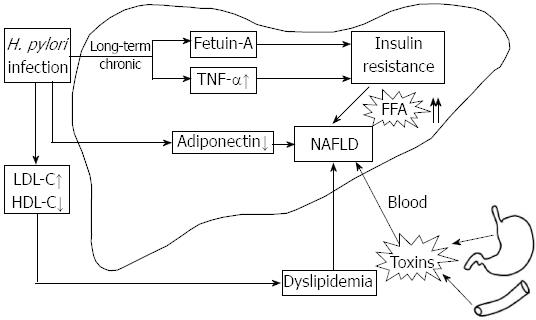Copyright
©2013 Baishideng Publishing Group Co.
World J Gastroenterol. Nov 7, 2013; 19(41): 7024-7031
Published online Nov 7, 2013. doi: 10.3748/wjg.v19.i41.7024
Published online Nov 7, 2013. doi: 10.3748/wjg.v19.i41.7024
Figure 1 Potential mechanism of how Helicobacter pylori contribute to nonalcoholic fatty liver disease.
Insulin resistance (IR) may be an important link between Helicobacter pylori (H. pylori) infection and nonalcoholic fatty liver disease (NAFLD). IR favors accumulation of free fatty acids (FFAs) in the liver. H. pylori-induced IR may be mediated through fetuin-A. Tumor necrosis factor (TNF)-α plays a central role in the response to inflammation elicited by long-term H. pylori infection. The decrease in adiponectin is implicated in H. pylori-induced NAFLD. H. pylori toxins arising from the gastrointestinal area may cause liver damage. H. pylori may be associated with the altered lipid profile, leading to dyslipidemia, which is involved in the pathogenesis of NAFLD.
-
Citation: Li M, Shen Z, Li YM. Potential role of
Helicobacter pylori infection in nonalcoholic fatty liver disease. World J Gastroenterol 2013; 19(41): 7024-7031 - URL: https://www.wjgnet.com/1007-9327/full/v19/i41/7024.htm
- DOI: https://dx.doi.org/10.3748/wjg.v19.i41.7024









